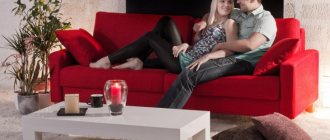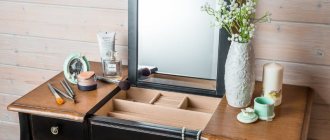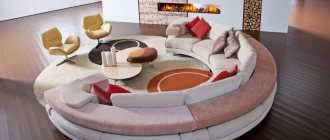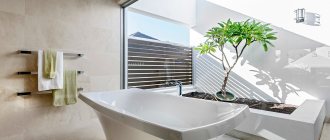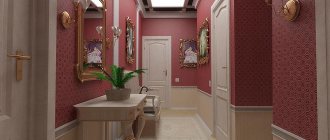Hallway. This room plays a significant role. Already upon entering you can feel the harmony and mood reigning in the house. Here we meet dear guests, friends who have dropped in for a cup of tea. I want to create the perfect interior here. To do this you need to choose the right color.
Since hallways are most often small in size and at the same time they form the first impression of the home, you should approach the issue of their design carefully.
What colors to paint the hallway walls (photo selection)
When choosing color solutions for the corridor, take into account all the nuances, especially the length of the corridor and its layout. Not everyone can boast of a large room. Most often, the hallway is either too small or very long and limited in width. If you like dark shades, especially brown, then the visual width will be reduced even more.
Cool colors are best suited for a small corridor: white, pale chestnut, azure, ivory, silver, haze, light brown, grayish.
When deciding on a color, take into account the area and configuration of the room.
The most acceptable design is light brown and gray. Their highlight is neutrality. What does it mean: a shadow falls on a milky color - a grayish color is formed, and gray in combination with yellow produces a light brown color.
Hallway in gray: many shades
Beginners will be surprised to learn that a design with an emphasis on gray does not imply a monochromatic nature of the walls, ceiling and furniture. Metallic, silver, pearl and a number of other shades will help to place visual accents. The main thing is to maintain a balance between dark and light tones. Light shades always dominate, visually expanding the space and uplifting the mood.
You can get acquainted with interesting ideas for arranging a hallway in gray tones on the Internet or in fashion catalogs
There are several recommendations that can turn even a small hallway into a work of art:
- A bet on cool tones is justified only when it comes to the apartment of a business person. The guests' attention is focused on the pragmatism of nature, which prefers to rationally use every centimeter of space.
- In homes with children, it is recommended to choose warm shades. Firstly, there will be no difficulties in combining them with the dominant gray color. Secondly, the children’s hallway will not seem overly gloomy.
- If the house is often visited by easily excitable citizens or people with psychoneurological disorders, then the choice should be made in favor of a combination of gray with the addition of pastel shades.
When choosing a color, you need to remember the functional purpose of the hallway, as well as the degree of its illumination. The gray corridor prefers spot lighting.
Color scheme depending on the interior style
Classic style. Many people follow this direction. It’s not difficult to create – paint or wallpaper is used to decorate the walls. This style is characterized by a wide range of colors, a combination of large elements, images, ornaments, and monotony. In some cases, it is more expedient to decorate the hallway with panels - this is one of the commonly used finishing options today.
When choosing the color of the walls in the corridor, first of all, select washable finishing options.
This style is characterized by the following combination: grayish with light brown, sandy with milky, dark with red, chestnut with red, light purple with light brown, milky with azure.
With a small footage, it is better to choose one of the above tones, and it is better to refrain from designing 3D or large drawings. If you live in a private house, the color should be soft and calm, otherwise it will seem that the walls are pressing. No one will like this feeling.
Whatever color you prefer, either paint or wallpaper should be moisture-resistant and preferably with an anti-fungal coating.
For decoration, use higher quality wallpaper than paper. These include non-woven, glass wallpaper, vinyl, but they also cost a little more than usual.
It is better to decorate the walls in a small hallway in light and warm colors; they will significantly expand the space.
Modern style. You haven’t decided which tone to choose yet, but you want to design it in accordance with fashion trends, the following materials and coatings are suitable.
- Natural and artificial stone of remarkable, colorful colors (rich gray, purple, dark, burgundy, chestnut).
- Red brick with clearly marked seams.
Brick. With its help, you can decorate all the walls in the hallway or apply only partial decoration and create a rather unusual design in the hallway.
- They use paints of pistachio, dark, azure, bluish, scarlet, red, greenish shades. If the hallway is spacious, you can combine colors with soft, neutral tones. Interior and decorative paints are suitable for any style.
- You can separately use dim, soft shades. Of these, light brown, milky, and light yellow are often used.
A dimly lit hallway should be decorated in light colors.
Additional Information. If your main goal is to visually expand the room, then paint or decorate the side walls with the lightest colors or finishing materials. Refrain from large elements, massive pieces of furniture, large niches - this will visually significantly reduce the hallway.
Retro style. Using stone is an acceptable option. Here it is permissible to use stones of different volumes. The main requirement is that the objects have relief outlines, are bulky, and have rigid contours. This will allow the wall covering to look natural, realistic, like in the old days.
Whatever colors of walls, furniture, and interior items you choose, the color scheme should vary within no more than three shades.
A distinctive feature of this direction is the use of natural decoration and established colors. The most suitable colors: light brown, milky cream, chestnut, sand. Contrast and brightness are unacceptable.
As for materials, use wallpaper, paint, and stones that imitate unevenness and wear. Decorative plaster will give the same result. Although it is expensive, it is used sparingly.
The relief surface with various patterns is perfect for decorating any style.
Scandinavian style. This direction is characterized by an abundance of light. It is worth using neutral, soft, cool colors, bright colors are unacceptable. It is recommended to dilute the selected shade.
Stylistic design allows not only to create a fashionable interior, but also to reflect taste preferences.
Don't just focus on pale gray or light brown. Sandy, light yellow, azure, and golden shades are ideal. For a small area, this is the best option that deserves attention.
High tech. This style is no less popular these days. Its key areas include the presence of elements of niches and metal decoration in the hallway.
Uncomplicated and simple types of functional finishing will emphasize the fundamental features of this direction.
The style is characterized by dark tones: dark, greenish, dark azure, silver, etc. The use of stones, wallpapering, and painting are not excluded.
Country style. A few words about the color scheme. Most suitable.
- Dark-brown matte colors, textures with imitation stains are the most acceptable option.
- Light brown and snow-white tones.
- Light yellowish and white rough planes.
- A color and structure combination is recommended.
- The background is better neutral, with the addition of colorful elements - this is necessary.
The room expands with mirrors, arches, and large passages.
Each style is unique and interesting in its own way. Thanks to its features, it helps to create a unique interior.
On a note. If you can’t make a choice on your own, contact a specialist. They will help not only choose a style, but also hide all the shortcomings of the room and create the perfect interior.
About the texture of color
Materials of different textures are another powerful design tool. Of course, handling it requires certain skills, but they are available not only to specialists. In a gray color in the hallway you can do virtually everything: from floor to ceiling, but the different textures of the coatings will do their job, and the interior will “sparkle.” In such a corridor you can connect:
- glossy shine;
- roughness vibrations;
- regularity of matte textures.
Try to make the walls a little lighter than the furniture and decor in the hallway. A very dark wardrobe or chest of drawers, dark interior doors are also undesirable; they rarely look convincing in a gray interior. Furniture in a gray room may well be light brown, white or light with a pinkish tint.
And almost always the final touch lies in some rich element of the space: a colorful picture on the wall, a crimson clock, a turquoise rug or a yellow metal shoe rack.
Gray and white hallway
Both dark gray and light shades of color make excellent partners. Color combinations are where design ideas come into play in unexpected and interesting ways. And the combination of gray and white is the most common, although not the brightest. This is a calm and measured union in which each of the colors can become the main one.
It is more convenient to combine 3 colors in this graphic combination - gray, white and black. This is a classic that allows you to make the space cozy, harmonious, and voluminous. The walls can be painted gray, the furniture will have black elements, the main color of the furniture and/or decor will be white.
You can make it simpler: gray walls, white furniture, 1-2 paintings in black frames and a black doormat or black clock frame.
Gray with blue/light blue
Gray with blue or blue is a rather cool combination, although many people like the corridor or hall in gray-blue tones. The question is how blue will appear. Will it be bright, dosed, or faded, blurry?
Why the corridor should be beautiful
This room needs beautiful decoration no less than other rooms. This is like a “business card” of the house, so you should approach the design thoroughly.
The background and patterns should not be too contrasting in hallways with a large wall area.
In addition, the corridor requires a lot of space for outerwear, shoes and other accessories. But all this must be combined with the decor. There is a large area for it - this is a wall. By decorating this surface, where there is no clothing, you can radically change the atmosphere here.
To transform the area at the front door, consider these points.
- Compactness - the dimensions here are smaller than in other rooms. In this regard, it is worthwhile to correctly approach the placement of the necessary items and create a design that visually expands this area.
- Thoughtfulness. When you return home from work, you want to plunge into comfort. Therefore, the design of the corridor should evoke only positive emotions, and the furniture should be cozy and multifunctional. Consider choosing a place for outerwear, shoes, mirrors to make it convenient.
- Quality. Choose high-quality materials, they will last a long time, but low-grade ones are unreliable and will soon need to be replaced. Pay attention to the moisture resistance of the material and ease of cleaning.
- Beauty. Every room in the house should correspond to this word. If you want to renovate the hallway yourself, work hard on the interior so that it matches the style of the entire apartment.
Make the floor darker than the walls, and the ceiling should be lighter than the floor. In this way, the proportions of the room are visually preserved and the space is not hidden.
Decoration for a small hallway
Small rooms require a particularly careful design approach. What color should I paint the room? It is not recommended to make the walls in such hallways monochromatic. For visual expansion, it is recommended to use horizontal stripes. Vertical lines will correct low ceilings, visually lifting them. The pattern does not always have to be straight lines; a pattern directed horizontally or vertically is sufficient.
The color scheme in a small corridor should not be too dark. It is best to paint in light cinnamon and beige shades with white and off-white trim. An interesting solution would be white and brown striped teeth. A white horizontal stripe on the wall under the ceiling will visually raise it. You can also use mirrors and metal trim pieces to expand the space.
Small rooms are very capricious in terms of design. The emphasis should be on functionality, but at the same time avoiding exaggerated minimalism.
Natural materials look good in a small apartment. Light wood trim will create a warm and cozy atmosphere, and if installed correctly, it will last for many years.
Related article: How to plan a dressing room: choosing a configuration, location and unusual ideas (+160 photos)
What color is better for the corridor
When starting a renovation, you want to carry out all the finishing work efficiently and choose the optimal design. But sometimes difficulties arise with choosing a color scheme. The best option will be the shade that will be combined with the home decor, interior and color of other rooms.
White. Many are sure that this color is not suitable for the hallway, that it is not entirely practical. Stylists are convinced that entering a white corridor improves your mood, and this is a strong argument in favor of white. In addition, the room visually increases. Of course, everyone finds their own advantages and disadvantages in milky color. But if you really want to decorate the interior this way, you shouldn’t give up your desires.
This wall design will be an excellent option for small or narrow spaces.
Light green. Green and its shades are becoming increasingly popular. When choosing a shade of green, the design you have in mind is also important. The corridor is small, light colors are ideal: light green, mint, grayish green. Appropriate finishing materials and decorative elements should be used.
Light green wall decoration is very fashionable, relevant and modern. With its help you can bring incredible freshness to your interior.
Note! This color is the basic one, and which tone is better to choose, be guided by the footage and shape of the corridor, the type of lighting.
For a large corridor, you can use the brightest colors of green. But you need to be careful, as its excess can cause an aggressive attitude. More saturated green shades are also suitable - darkish green, yellow-green, especially with high ceilings and an original layout.
A wall surface highlighted with an unusual texture, bright color or pattern is a special interior technique that guarantees an excellent result.
The inserts will give a unique effect. It is more correct to perform colorful inserts on a neutral background. This kind of contrast will make the room larger or visually make a large corridor smaller.
Light. Most people prefer the shade of coffee with milk as the most practical. Light brown decoration and furnishings are perfect for different styles. Combines perfectly with dark chestnut, cream, light green.
A well-placed mirror, by adding perspective, will give the room spatial depth and spaciousness.
Let us outline some of the advantages of a light shade.
- Decorating in such colors, including the floor and ceiling, requires fewer lighting fixtures.
- The light color perfectly hides unevenness and masks flaws in planning.
- Ideally combines with all colors, which greatly facilitates the work of stylists.
- With this design, any decorative element looks very impressive.
- Light decoration has a beneficial effect on the nervous system, making the house feel cozy and comfortable.
A good alternative to white is ivory. The shade is rich, goes well with many colors and looks presentable.
Among the disadvantages are the short service life of such a coating and the likelihood of staining the walls with outerwear or shoes. But the moisture- and wear-resistant materials currently produced will help to easily cope with this problem.
Grey. This color has many shades and is considered an excellent additional background for colorful elements used in the interior. Painting the walls in the hallway gray will help make the atmosphere in the room peaceful and also unusual.
It is recommended to give preference to light shades of gray, which will make the room airy, fresh and spacious.
Unlike light, this color is much more practical; it has several shades: asphalt, metal, pearl. They have a positive effect on a person, calm them down, relieve stress. But if there is an overabundance of dark gray in the corridor, it causes melancholy and despondency. Decorative plaster will add variety to such an interior; with its help you can recreate different textures.
Lilac. This color, like others, differs in the variety of palettes. Lavender is classified as a cool shade and is best used in rooms facing the sun.
The lighter color of lavender can be used in rooms where the windows face north.
The soft lilac tone is ideal for minimalist and classic styles. And in any other style it looks very impressive.
Some argue that this color is not suitable for large rooms where we are constantly and it is better to use it in small rooms. One can argue about this. If residents really like this shade and feel comfortable in such a room, it is quite advisable to use it for decoration. But moderation is needed in everything.
Dark. A darkly decorated corridor looks intimidating, especially if the lighting is incorrect. In a narrow room, it is better not to use dark colors. Neither thoughtful design nor proper lighting will help with this. A small corridor can be decorated with a dark-colored rug and a small painting; for furniture, choose a wenge tone - amber-chestnut or dark chestnut with black veins.
Dark walls will become the main accent and will look very elegant, chic and original.
To visually enlarge a dark corridor, it is better not to install interior doors, but to limit yourself to arches. A mirror is also used for this. It is better to choose a wall-mounted and wide one; a built-in one will not give such an effect. Suitable shades for the frame are silver or gold. LED lighting is required along the edges.
Bulky furniture is not suitable for a dark hallway - it makes it heavier. Shelves and hangers should be open; bedside tables should be low. Choose polished, glossy or mirrored items. Install multi-level lighting: chandelier, sconce, along the edges of the ceiling - diode contour strip.
Beige. “Business card” is also what the corridor is called, because its appearance forms an opinion about the owners. Therefore, they try to create a beautiful interior here. But this is complicated by the constant movement in the room, the fact that its area is small, and there is no natural lighting.
Painting the walls gray or beige switches attention from form to content - a small hallway in neutral shades will seem a little larger than it actually is.
The best color for decoration is beige; it will visually enlarge it and add light. Pairs perfectly with all colors. You can easily pick up furniture and decor here. Beige shades will add comfort and harmony to the interior.
Backlight
Lighting is used to zone rooms or create accents on certain details. A place with mandatory enhanced lighting is next to the mirror. You can experiment with other areas of the corridor.
Colored lighting in a hallway with plain walls will create a completely different mood. And the color of the lamp is easy to change if desired.
The color of the light source also plays an important role. Green is best used in the relaxation area, golden or pinkish in front of the mirror. Cool tones visually expand the rooms. Movable lighting fixtures will create an interesting effect in any functional area.
Before choosing what color to paint the hallway, you need to take into account all the functional features so that the color scheme improves the appearance of the hallway. A good hallway interior is very important because it sets the mood when you enter your home.
Article on the topic: Hallway - interesting interior in Khrushchev
Hallway in white and brown tones (2 videos)
Color options for the hallway (38 photos)
The best posts
- Hallway interior: color and design (+30 photos)
- Hallway - interesting interior in Khrushchev
- Design of a corridor in an apartment (+50 photos)
- Long hallway design ideas: accents and interesting solutions
- Decorating a hallway in Provence style: photos of interiors and general tips
- Choosing a color for the hallway: a harmonious combination of shades in accordance with the interior style
- Mirrors of various shapes and types for the hallway
- Interior of a long corridor - planning a narrow space
Fashionable design solutions in 2020 (photo selection)
Let's look at the fashion trends in hallway design for this year:
- When creating the interior of a hallway, it is important to plan the arrangement of furniture. Since there are few free walls left, finishing plays a secondary role.
- Repair is made difficult by a large number of items. Be smart and embrace minimalism.
- Use no more than three colors for finishing: wood, white, gray or dark. Everything in the hallway has its own colors, for example, a wood floor, a snow-white ceiling, a dark rug. These colors are present in almost every interior. If you bring in bright colors, it will look pretentious and ridiculous.
- The hallway with built-in furniture and hidden LED lighting matches the fashionable design.
If the hallway is designed in a neutral color and without bright accents, then you can choose combinations of colors that are similar in color palette.
When decorating a small corridor, the priority should be neatness and functionality. Make the background in neutral colors, and we recommend choosing decorative plaster for finishing materials. It is reliable, stains are not visible on it, and is easy to clean. If you wish, you can choose wallpaper for painting or painting. If you have a spacious hallway or are planning a redevelopment, then the design will be completely different. For finishing you can choose several materials.
Textured surfaces add variety to the interior of a gray hallway. The texture can be created using decorative plaster.
When designing a corridor, its functionality comes first, and its elegant appearance, comfort, and convenience come second. It is important to observe moderation in everything.
Choosing a color for a narrow hallway
A narrow corridor seems inconvenient to many. Only place cabinets along the walls, which, by the way, are constantly getting dirty. Pasted wallpaper often breaks because it gets touched by bags and outerwear, so the best option is to paint the walls.
Related article: Hallway interior: color and design (+30 photos)
A narrow corridor imposes certain restrictions on the selection of colors. The main rule is not to overload the corridor with an abundance of flowers.
It is important to make a narrow corridor well lit not only through lamps.
White would be an excellent solution, but its downside is impracticality. This does not mean that it cannot be used in the hallway at all. A snow-white finish on a burgundy or dark blue background will look very impressive. If you do not want such experiments, it is recommended to choose light and delicate colors. Pay attention to the cool color scheme, which will help create a feeling of airiness in the interior.
Avoid monotony, it will tire you. You can create a smooth transition from a light shade to a darker one throughout the entire corridor. Another solution is to create an interesting texture on the walls, such as plastering before painting.
